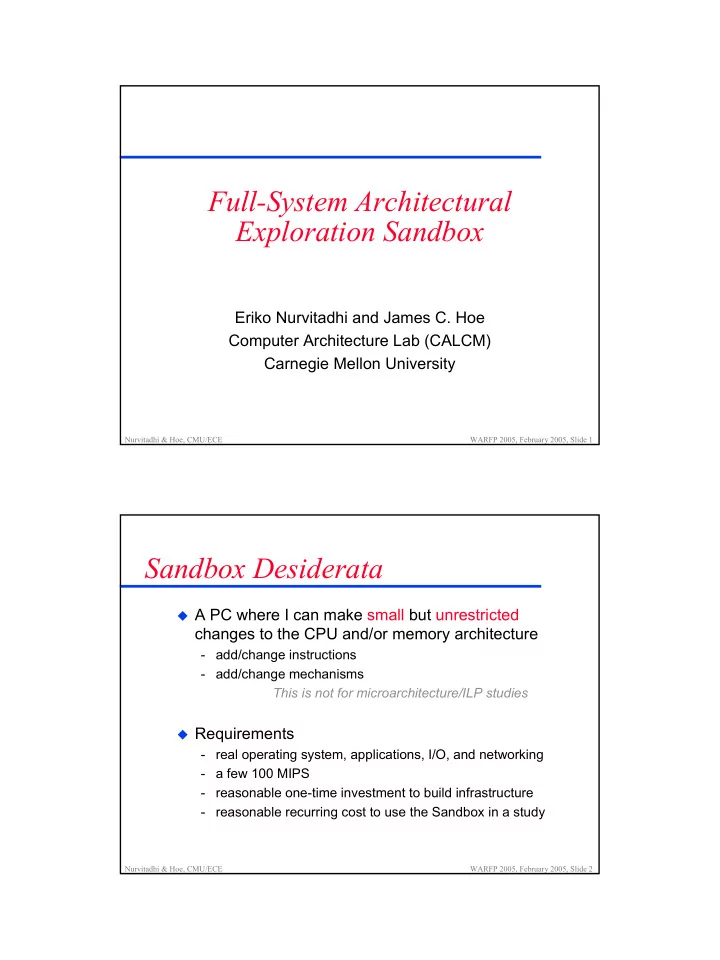

Full-System Architectural Exploration Sandbox Eriko Nurvitadhi and James C. Hoe Computer Architecture Lab (CALCM) Carnegie Mellon University Nurvitadhi & Hoe, CMU/ECE WARFP 2005, February 2005, Slide 1 Sandbox Desiderata � A PC where I can make small but unrestricted changes to the CPU and/or memory architecture - add/change instructions - add/change mechanisms This is not for microarchitecture/ILP studies � Requirements - real operating system, applications, I/O, and networking - a few 100 MIPS - reasonable one-time investment to build infrastructure - reasonable recurring cost to use the Sandbox in a study Nurvitadhi & Hoe, CMU/ECE WARFP 2005, February 2005, Slide 2 1
Sandbox Platform . 4 P ? r o A f G T P - M F CPU 0 n 4 M.C. o local FPGA d t e FPGA n bus n e hard disk g d local ethernet i u s t SRAM e s d 1 Processor Module s h r e t i e w n i 6 g PCI Bus 8 n x e n l e a t e n host k I host a 0 memory 0 m DRAM 5 o bridge t Sandbox PC System w o H host CPU Nurvitadhi & Hoe, CMU/ECE WARFP 2005, February 2005, Slide 3 We can do it because … � We don’t need a P4 - detailed microarchitecture and ILP are second-order - DRAM and I/O devices are relatively faster Pentium or simpler will suffice for IPC=1 at 100MHz � We don’t need “full” x86 compliance - use C++ code from Bochs as ISA spec - use Bochs simulation for reference behavior (http://bochs.sourceforge.net) Bochs-compliance is good enough to boot Linux and Windows � We can use high-level HDL and FPGA - emphasis on correctness rather than optimality - incremental development Nurvitadhi & Hoe, CMU/ECE WARFP 2005, February 2005, Slide 4 2
Preliminary Experience � x86 CISC instruction decoding - as little as 1 byte, as many as 16 bytes per instruction - yields 947 distinct behaviors (according to Bochs) only 558 in pre-MMX x86 - a major source of complexity in real x86 implementations the real reason there is a trace cache in Intel P4 � Bochs C++ to VHDL - naïve, straightforward translation of C++ code to combinational logic in VHDL - synthesize to Xilinx XC2V6000-6 • 5% resource • 50MHz Nurvitadhi & Hoe, CMU/ECE WARFP 2005, February 2005, Slide 5 Bochs Example: BX_CPU_C::ADD_EbGb BX_CPU_C::ADD_EbGb(bxInstruction_c *i) { Bit8u op2, op1, sum; op2 = BX_READ_8BIT_REGx(i->nnn(),i->extend8bitL()); if (i->modC0()) { op1 = BX_READ_8BIT_REGx(i->rm(),i->extend8bitL()); sum = op1 + op2; BX_WRITE_8BIT_REGx(i->rm(), i->extend8bitL(), sum); } else { read_RMW_virtual_byte(i->seg(), RMAddr(i), &op1); sum = op1 + op2; Write_RMW_virtual_byte(sum); } SET_FLAGS_OSZAPC_8(op1, op2, sum, BX_INSTR_ADD8); } Nurvitadhi & Hoe, CMU/ECE WARFP 2005, February 2005, Slide 6 3
To Conclude � A powerful tool for architectural studies - complete control of CPU and memory controller - run real operating system and applications � I am not saying it is easy, but it definitely is doable - Bochs as specification and reference behavior - incremental development in FPGA � Why not just use SIMICS, Bochs, etc? - 10 MIPS out of the box, but performance degrades very quickly when you tack on new behavior or detail � Why not use Pentium RTL models? - real RTL models are hard to come by - real RTL models are impossible to modify Nurvitadhi & Hoe, CMU/ECE WARFP 2005, February 2005, Slide 7 TRUSS Computer Architecture Lab (CALCM) Carnegie Mellon University http://www.ece.cmu.edu/CALCM Nurvitadhi & Hoe, CMU/ECE WARFP 2005, February 2005, Slide 8 4
Recommend
More recommend